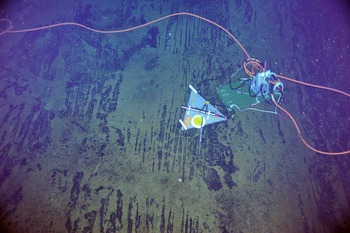The past day and today have been incredibly busy with four ROV dives to the seafloor. The ROPOS team was highly efficient with some vehicle turn-around-times of <3 hrs. Most vehicles take much longer than this. The dives focused on the International District hydrothermal field and the Eastern Caldera and Central Caldera sites.
During this past (intense) 24-hour period, two Junction Boxes and three instruments were deployed and connected at Axial Seamount during dives R1717-R1719. Junction Boxes MJ03C and MJ03D were installed in the International District 1 and 2 Sites, respectively, at a water depth of ~1500 m. MJ03C was connected to an extension cable 7545 feet in length that extends up to Primary Node PN3B, which will provide power and communications to all of the infrastructure on Axial Seamount (this cable is not yet plugged into the Primary Node). The J-box MJ03D was also installed and connected to a similar cable that runs up to PN3B that will host an array of geophysical sensors.
A short-period seismometer was also installed in the International District field and connected to MJ03D. The short-period seismometer will listen to and monitor the "heart beat" of the volcano, measuring numerous, small earthquakes that occur within the core of Axial Seamount. A temperature-pH-H2S sensor is hosted within the MJ03C node, awaiting installation in the vent called Diva. Diva vents high-temperature fluids extremely enriched in the gas carbon dioxide. This sensor will measure the acidity (pH) and hydrogen sulfide concentration of the fluid (important for animal growth), and temperature. A current meter was also deployed with this J-Box.
We also had great fun exploring the hydrothermal vent called El Gordo in the International District. This chimney hosts rich biological communities and is the installation site for a mass spectrometer, digital-still camera, and fluid and microbial DNA sampler. We also visited the high-temperature chimney called Escargot, and found a beautiful octopus "hanging out" on a ledge above the seafloor.
Following that survey, ROPOS transited to the Eastern Caldera Site and documented deployment sites for a broadband seismometer and hydrophone. Once ROPOS was on deck, planning and the rigging for the trawl wire deployment of the ROCLS unit with 15,000 m of cable attached commenced. That dive is now underway.




